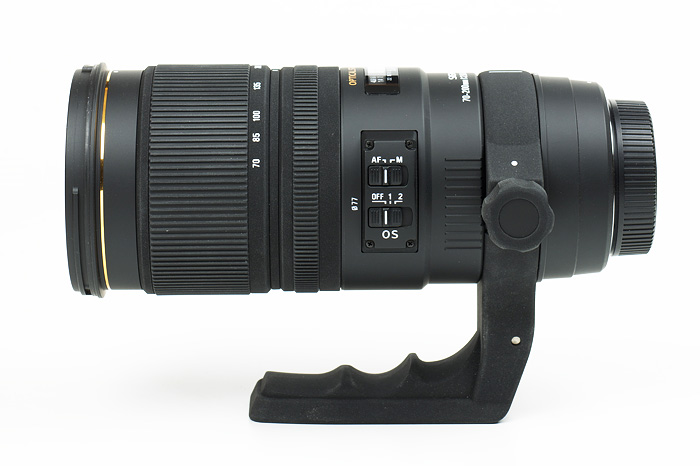|
Page 1 of 3

Review by Markus Stamm, published August 2012
Special thanks to Markus Jakobsen for providing one of the review units.
Introduction
The product life cycle of a lens usually covers several years, if not a decade or even more. As with any rule, there are exceptions, and the Sigma EX 70-200/2.8 is certainly one of them. The initial product was launched back in 1998, when Sigma introduced the EX 70-200/2.8 APO as one of the first lenses to carry the "EX" designation. That lens remained a current product for 7 years. From 2005 onwards however, Sigma's product managers switched into fast pace mode. The Sigma 70-200/2.8 EX OS HSM, announced in 2010, is the 4th update to the initial product within less than 5 years:
- 2005: Sigma AF 70-200mm f/2.8 EX DG HSM
- 2006: Sigma AF 70-200mm f/2.8 EX DG Macro HSM
- 2007: Sigma AF 70-200mm f/2.8 EX DG Macro HSM II
- 2010: Sigma AF 70-200mm f/2.8 EX DG OS HSM
The latest upgrade added optical stabilization (OS), a feature that has been offered by Nikon and Canon for quite some time now. With this feature added, Sigma was the first 3rd party manufacturer that was able to fully compete in this segment with the original manufacturers, at least on paper.
In this review we'll have a look at how the lens performs on our current FX test camera, the Nikon D3x.

The lens carries the EX designation and thus is part of Sigma's high-end lens collection. Consequently, the build quality is on a very high level. The lens feels very solid and there is no wobbling at any part.
Sigma EX lenses nowadays feature a rubber-like smooth coating, however one of our review units (we went through three units for this review) was a "hybrid" model, probably from one of the first production batches. It showed the new EX finish on the lens tube, but the old style crinkle finish on both the zoom and focus ring (visible in the image at the bottom of this page). The "trio" shot below illustrates what a current production lens looks like.
Sigma provides a petal shaped lens hood. DX users can mount an extra extension barrel for even more efficient light shading (more on that in our upcoming DX review of the lens).

The focus and zoom rings operate very smoothly and slightly damped. The length of the lens remains constant regardless of the focus and zoom settings. Thanks to an IF (internal focusing) design the front element does not rotate so using a polarizer is no problem. Like all high-end Sigma HSM lenses it features a hypersonic AF motor providing very fast and silent AF operations as well as manual focus override at any time.
Both the zoom and the focus ring work in "Canon" style, which is the exact opposite of how these rings work on Nikkor lenses. If you're used to the Nikon way of zooming, the Sigma lens may be a challenge for your muscle memory. And if you try to focus manually, you'll have to remember that the focus assist in the viewfinder assumes a Nikon lens and consequently suggest the wrong direction of focus ring movement.
Talking about "Canon style": the optical stabilizer (OS) of the Sigma lens offers two modes, that closely match the two modes available on Canon IS lenses. Unlike Nikon VR lenses, which offer a "normal" mode with panning detection and an "active" mode to deal with more pronounced vibrations (but without panning detection), the Sigma features mode 1 for full stabilization of both axis, while mode 2 is designed for panning and limits correction to a direction vertical to the panning movement.
Sigma claims a benefit of up to 4 f-stops for its OS (Optical Stabilizer). However, this seems to be a bit optimistic. You may be lucky at times with shutter speeds that slow but it's more realistic to expect a gain of up to 3 f-stops in field conditions. Subjectively, the OS implementation in this lens performs on the same level as the VR II module in Nikon's current 70-200/2.8 lens.

The lens comes with a removable tripod collar included. In addition, it is compatible with the optional and larger (and somewhat expensive) Sigma TS-41 collar, that offers an increased distance from lens body to mount plate. That additional space makes the setup more comfortable to handhold and carry (also due to the grip's shape) and can also give enough clearance to use the lens with large cameras (or a DSLR with additional battery grip) on some ballheads, on which otherwise the camery body could collide with the head's controls when rotated. On the other hand, the larger collar of course needs a lot more space in your camera bag.
The lens is compatible and offers full AF functionality with both current Sigma APO DG tele converters.
The Sigma AF 70-200mm f/2.8 EX OS HSM is a G-type lens and thus does not offer an aperture ring.
| Specifications |
|---|
| Optical construction | 22 elements in 17 groups inc. 2 FLD and 3 SLD elements |
| Number of aperture blades | 9 (rounded) |
| min. focus distance | 1.4 m (max. magnification ratio 1:8) |
| Dimensions | 86.4 x 197.6 mm |
| Weight | 1430 g |
| Filter size | 77 mm (non-rotating) |
| Hood | bayonet mount, petal-shaped, supplied |
| Other features | Lens provides distance (D) information. Removable tripod collar. Optical stabilization (OS) |
|